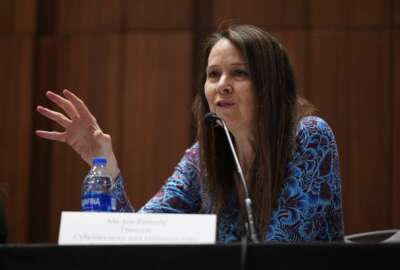DHS aims to expand CTMS after ‘challenges’ with rollout
CTMS hasn’t been the immediate shot in the arm some thought it would be, but DHS’s CIO says it’s a key part of the department’s future.
The Department of Homeland Security’s Cyber Talent Management System is picking up steam after some initial challenges, with DHS nearing 200 hires under CTMS.
DHS Chief Information Officer Eric Hysen said his office, the Cybersecurity and Infrastructure Security Agency, and the Federal Emergency Management Agency have collectively hired 189 individuals using CTMS. The CIO’s office and CISA were the first DHS organizations to use the new talent system. FEMA gained authority to use CTMS last year.
“We are pushing to aggressively expand CTMS,” Hysen said during a House Homeland Security Committee hearing on Wednesday. “We are working to bring it onboard with additional components. We are also looking across the offices that are already using it to expand utilization for some of their existing hires.
CTMS is exempt from many of the federal government’s traditional competitive hiring and compensation practices. The goal is to enable DHS to more quickly recruit and onboard talented cybersecurity professionals.
The system represents a major civil service reform effort. But the program’s slow rollout has led some lawmakers to question whether it’s working.
“While CTMS is a major value-add to the department, its rollout was not without challenges,” Hysen wrote in his prepared testimony. “It took us too long from receiving this authority to launch the program and begin hiring under it, and our initial rate of hires have not met our aggressive targets. Designing and launching an entirely new personnel system in the Federal Government is an extremely difficult task, and we learned from these efforts.”
He said DHS is working with hiring managers “to make it a more effective tool.”
“We knew that simply eliminating a step in the hiring process or adding a pay grade would not do enough to make DHS competitive, so we designed CTMS as a true attempt at civil service reform,” Hysen continued. “It is a complex, transformative, and challenging effort, but necessary to position the department for long-term success.”
CTMS ‘not going to be the answer for every position’
Last year, CISA Director Jen Easterly acknowledged her agency was continuing to use traditional Title 5 practices for most hires. Easterly also said CISA wanted to ramp up its use of CTMS.
While the new system contains more flexibilities around compensation and grade, officials have said it also features a “rigorous process” for skills identification and interviews.
Beyond CTMS, DHS has been leveraging direct-hire authorities granted by the Office of Personnel Management for artificial intelligence positions.
During this week’s hearing, Hysen acknowledged “CTMS is not going to be the answer for every position.”
“Traditional Title Five hiring will still play an important role,” he said. “That’s why we’re looking to streamline through leveraging direct hire authority from OPM and other sources of traditional hiring.”
Still, Hysen said the new talent system has allowed DHS to establish a “ready talent pool” of candidates.
“So that when we have vacancies arise, we can reach out to candidates that have gone through the first stages of their assessment process already and then just start from there, which significantly can significantly reduce time to hire,” he said.
DHS is also aiming to re-balance its mix of federal employee and contractor workforce. Hysen said the department is using CTMS to “look at areas where we need more federal technology expertise in our workforce.”
“We’ve done that with our network operations and security center where we have been rebalancing what was predominantly a very contract heavy workforce and are now adding in additional levels through these new hiring authorities of federal personnel,” Hysen said. “It’s something we’re looking to expand.”
Security clearances are another factor in holding up cyber hiring across DHS, Hysen said. The CIO said the department is looking to reduce requirements for security clearances.
“If you’re not going into a SCIF, looking at classified material, we shouldn’t be holding up your hiring on that,” Hysen said. “So we have been looking to reduce requirements, expand the use of interim clearances at both the secret and top secret level, which can be issued faster, as well.”
Copyright © 2025 Federal News Network. All rights reserved. This website is not intended for users located within the European Economic Area.
Follow @jdoubledayWFED






